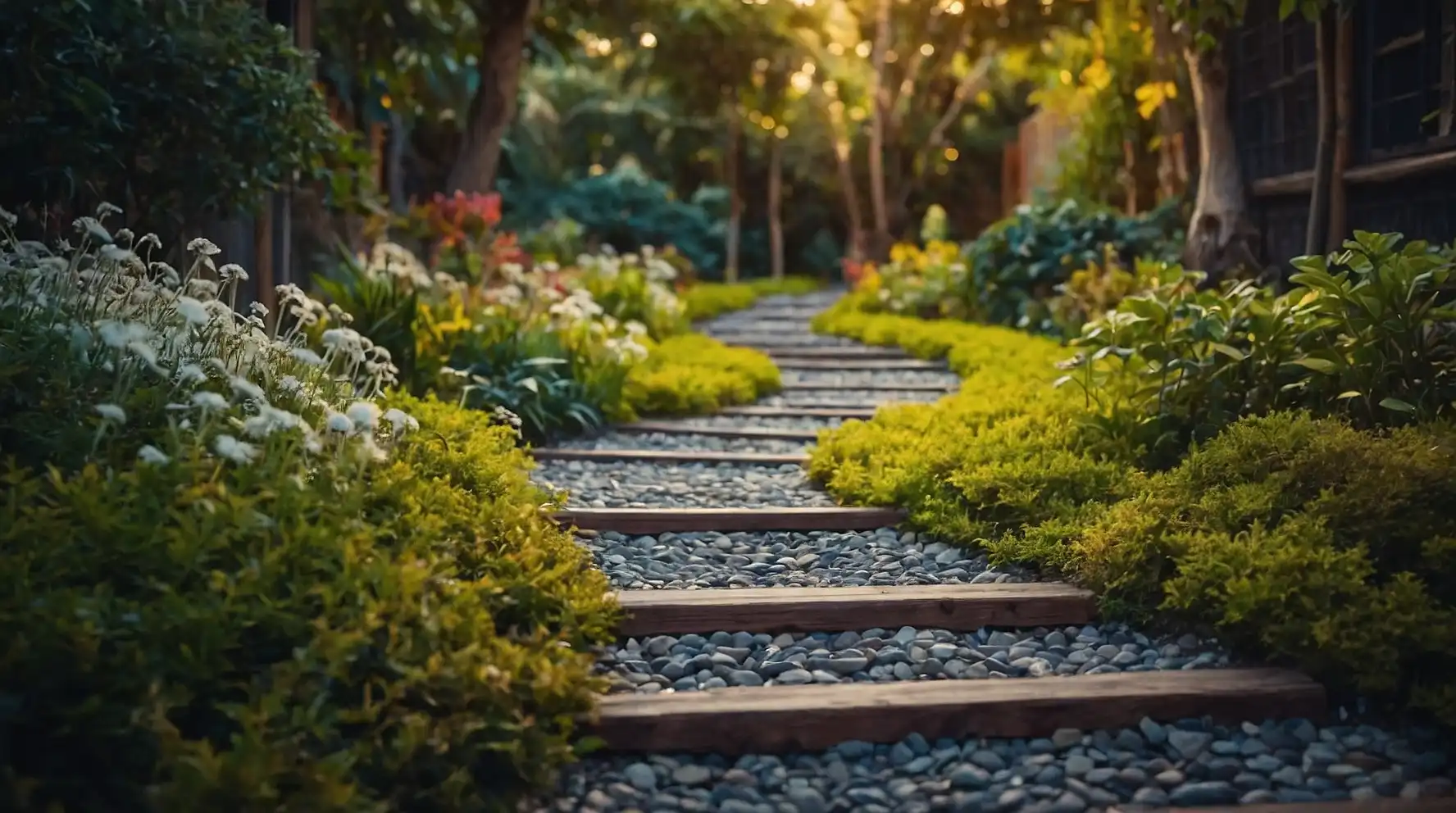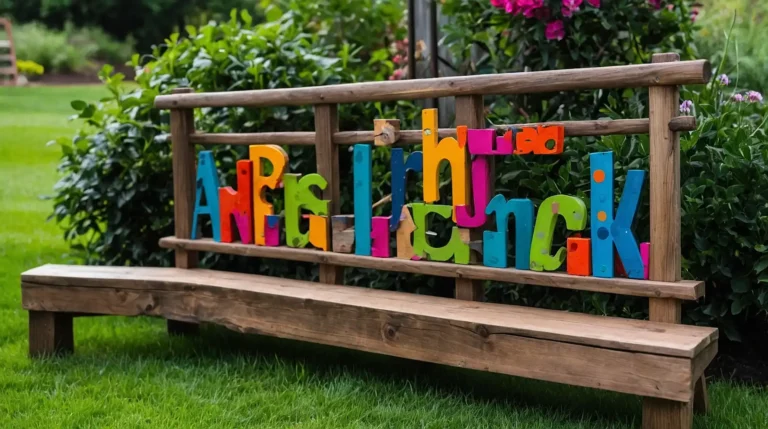27 Creative Pathway Ideas to Transform Your Yard into a Magical Journey
Garden pathways do more than connect different areas of your yard—they guide the eye, influence movement, and create opportunities for discovery and delight.
A well-designed path transforms an ordinary landscape into an immersive experience.
Beyond basic concrete sidewalks or standard pavers lie countless creative options that add personality and charm to your outdoor spaces.
The right pathway complements your garden style while serving practical needs like access and erosion control.
Ready to create a more dynamic landscape?
Explore these 27 creative pathway ideas that balance beauty, function, and unique character to enhance your yard’s appeal and enjoyment.
1: Stepping Stone Mosaic
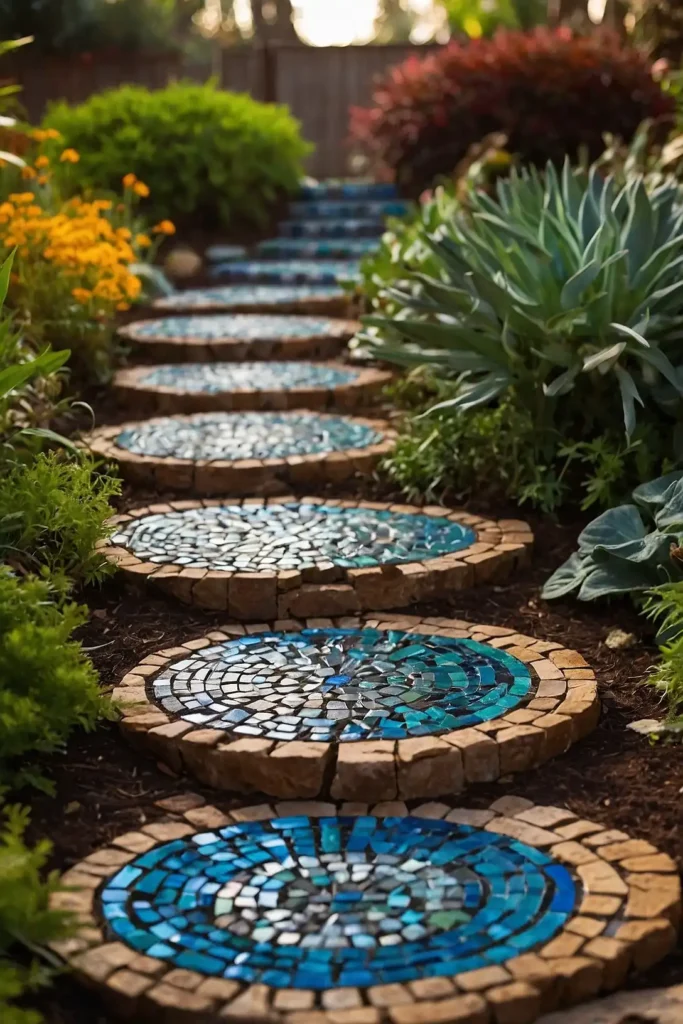
Create a playful, artistic path using custom mosaic stepping stones that showcase your personality.
This distinctive approach turns functional garden elements into individual works of art.
Design your own patterns using colorful tiles, glass pieces, marbles, or found objects embedded in concrete.
You can create thematic stones reflecting your interests or simply explore abstract patterns and colors.
Space these decorative pavers among ground cover plants or gravel to create a visually interesting journey through your garden that reveals new details with each visit.
2: Circular Paver Design
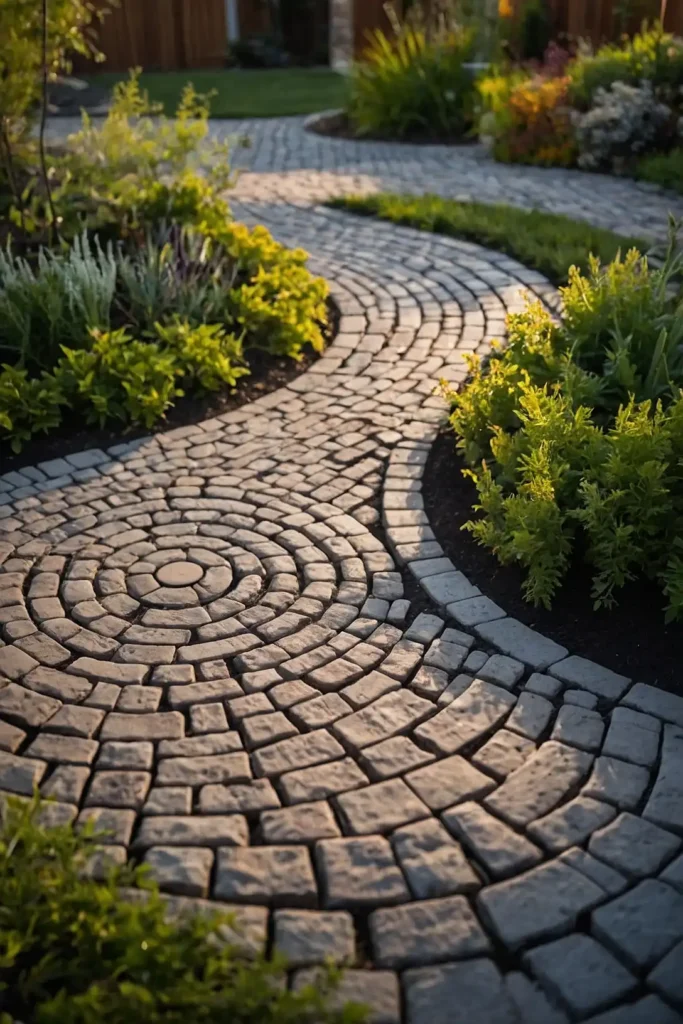
Install round concrete pavers in an organic, flowing pattern to create a softer, more natural-looking pathway.
This approach breaks away from rigid linear designs for a more relaxed garden feeling.
Vary the placement density—clustering pavers more closely in some areas and spreading them further apart in others—to control walking pace through different garden sections.
This creates a rhythm to your landscape journey.
Complete the look by allowing low-growing groundcover to spill slightly over the edges, softening the transition between pathway and planted areas.
3: Log Slice Walkway
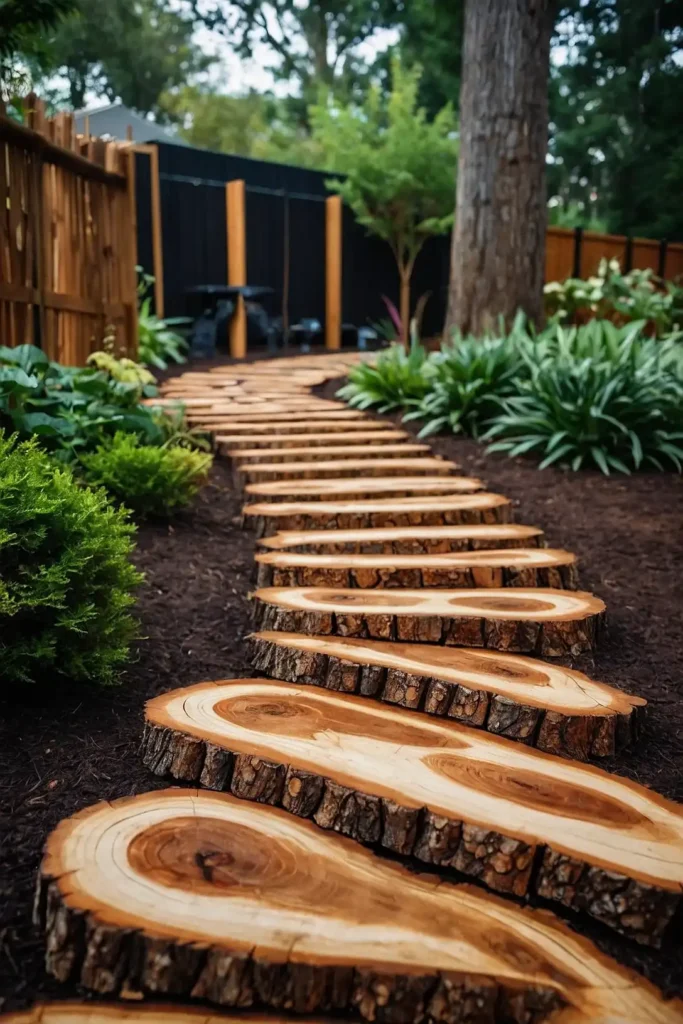
Transform fallen trees or pruned limbs into a rustic pathway by cutting them into uniform slices and placing them like stepping stones.
This sustainable approach repurposes natural materials while creating woodland charm.
Select hardwood varieties for maximum durability and treat the wood with a non-toxic preservative to prevent rot and extend lifespan.
Sand the top surfaces smooth to provide safe footing.
Embed the slices partially into the soil or gravel base to prevent shifting, and allow moss to gradually colonize the edges for an established, organic appearance.
4: Living Carpet Pathway
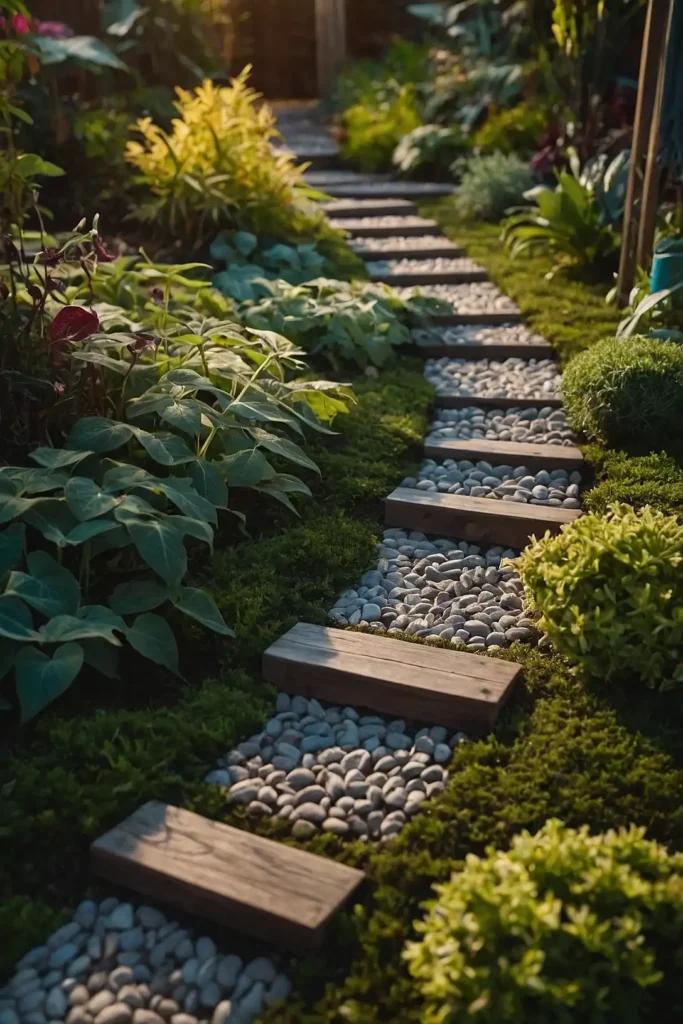
Create a walkable living carpet by planting low-growing, foot-tolerant herbs or groundcovers between stepping stones or pavers.
This sensory-rich path fills the air with fragrance when walked upon.
Choose hardy, spreading varieties like creeping thyme, Roman chamomile, or Corsican mint that withstand light foot traffic while remaining lush.
Different selections offer varied textures and seasonal flowers.
Install larger stepping stones or pavers for primary foot placement, allowing the plants to fill gaps between them for a green pathway that remains practical in all seasons.
5: Japanese-Inspired Stone Path
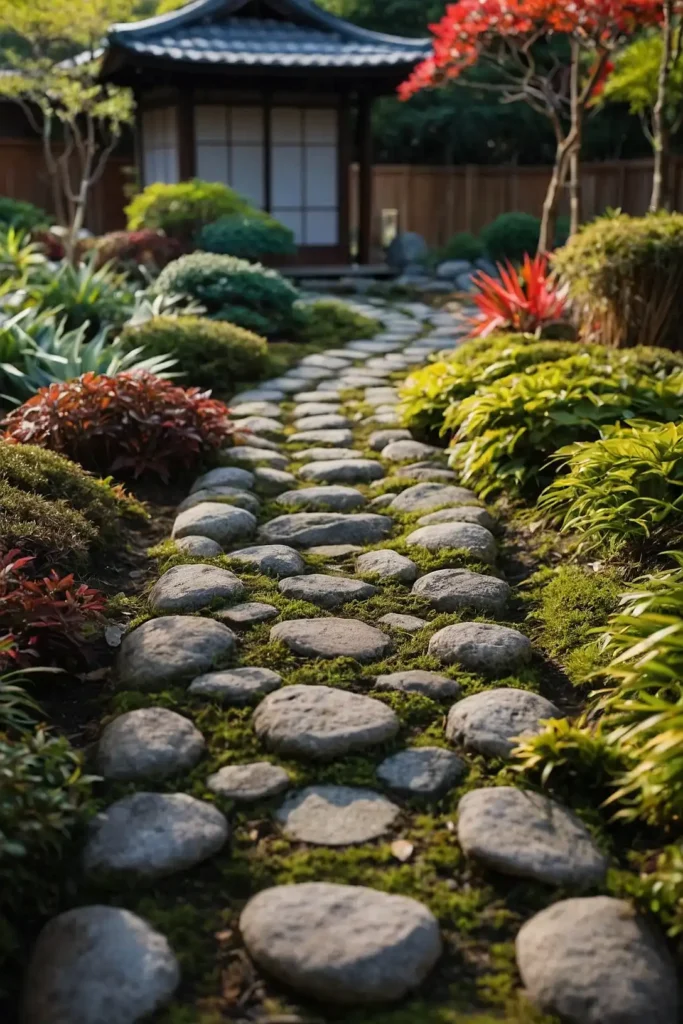
Design a contemplative pathway using carefully placed natural stone slabs with intentional spacing that slows movement and encourages mindfulness.
This Zen-inspired approach brings tranquility to your garden journey.
Select flat stones with interesting shapes and textures, positioning them slightly offset from a straight line to create a more natural rhythm.
The irregular spacing requires attention to each step.
Surround the stones with fine gravel, carefully raked into patterns, or plant low-growing moss between them to complete this meditative garden feature.
6: Rainbow Glass Mulch Path
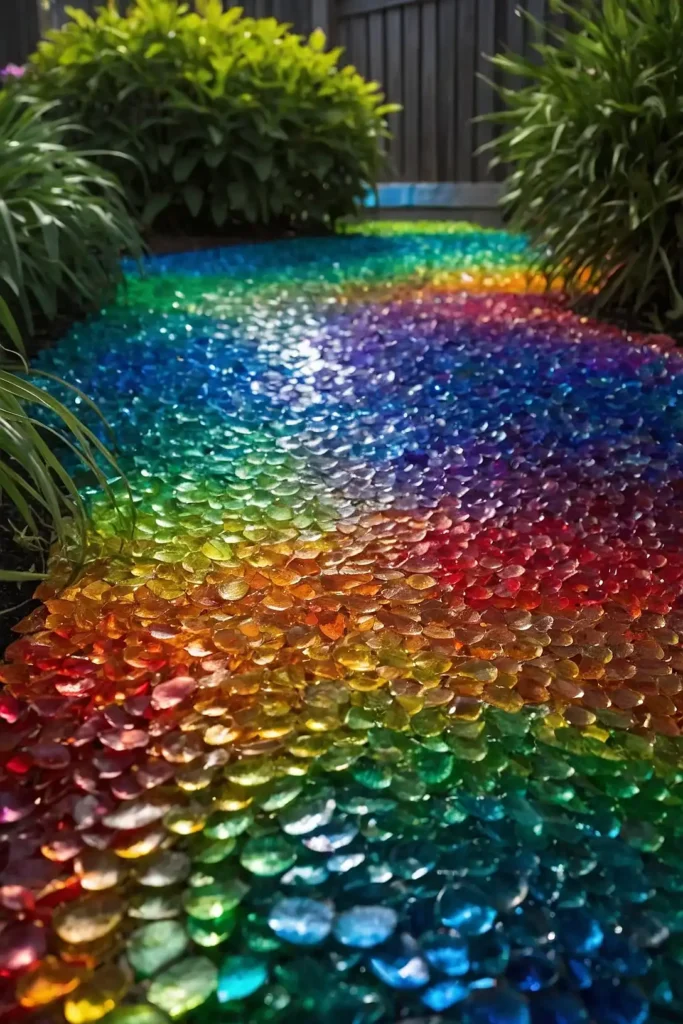
Create a magical, light-catching pathway using recycled tumbled glass mulch in vibrant colors.
This unexpected material adds whimsy and sparkle to garden borders and transitional spaces.
Choose a single bold color that complements your garden palette or create a rainbow effect with different colored sections.
The smooth, tumbled glass is safe for walkways and reflects light beautifully.
Edge your path clearly with metal, stone, or sturdy plastic borders to contain the glass pieces and prevent them from migrating into lawn or planting areas.
7: Pallet Wood Boardwalk

Repurpose wooden pallets into a rustic boardwalk-style path that adds elevation and texture to your garden.
This sustainable approach creates a distinctive walking surface with reclaimed materials.
Disassemble pallets and re-configure the boards across support beams to create a smooth, even walking surface.
Sand rough edges and treat the wood with eco-friendly sealant for longevity.
Elevate the structure slightly above ground level to improve drainage and prevent rot while creating an interesting transition between different garden heights or features.
8: River Rock Mosaic
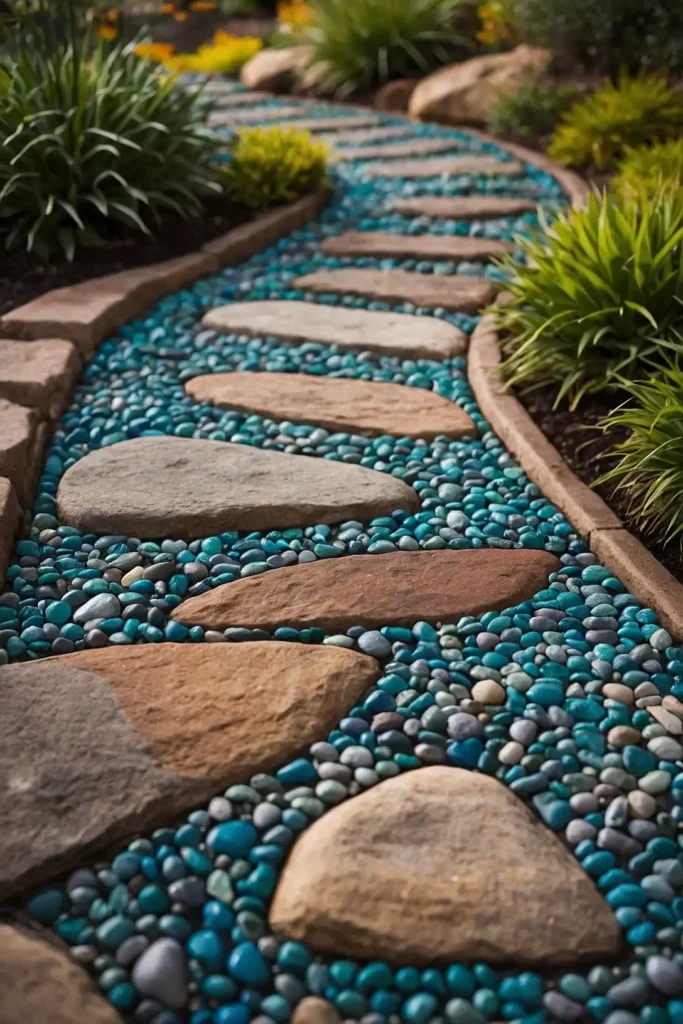
Design a flowing pathway using smooth river rocks arranged in mosaic patterns that mimic water movement through your garden.
This natural approach adds organic texture and visual interest.
Sort collected or purchased river stones by size and color, then arrange them in swirling patterns that suggest rippling water. Set them in concrete or firmly into compacted sand for stability.
This design particularly complements water features, rain gardens, or meditation spaces where the stone pattern reinforces connections to natural water elements.
9: Illuminated Night Path
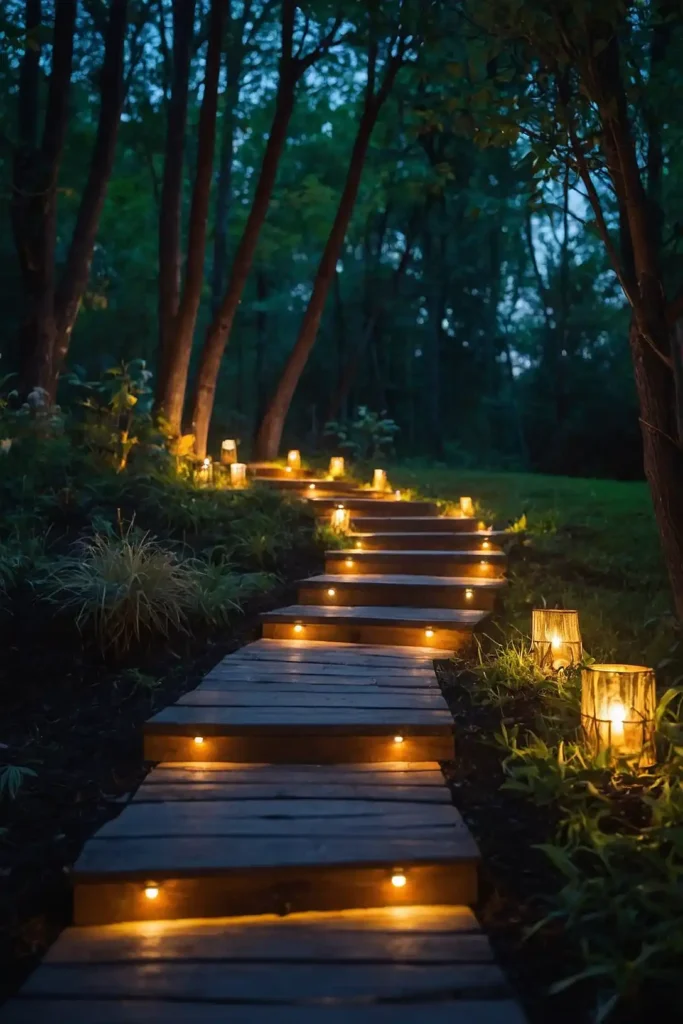
Create a magical evening experience by incorporating lighting directly into your pathway design.
This practical enhancement extends garden enjoyment into nighttime hours while improving safety.
Embed solar-powered path lights, glow-in-the-dark stones, or LED strip lighting along the edges or between pavers.
The lighting elements can remain subtle during daylight hours while becoming prominent features after dark.
Program lighting to activate automatically at dusk, ensuring your pathway remains functional and enchanting regardless of when you venture into the garden.
10: Herringbone Brick Pattern
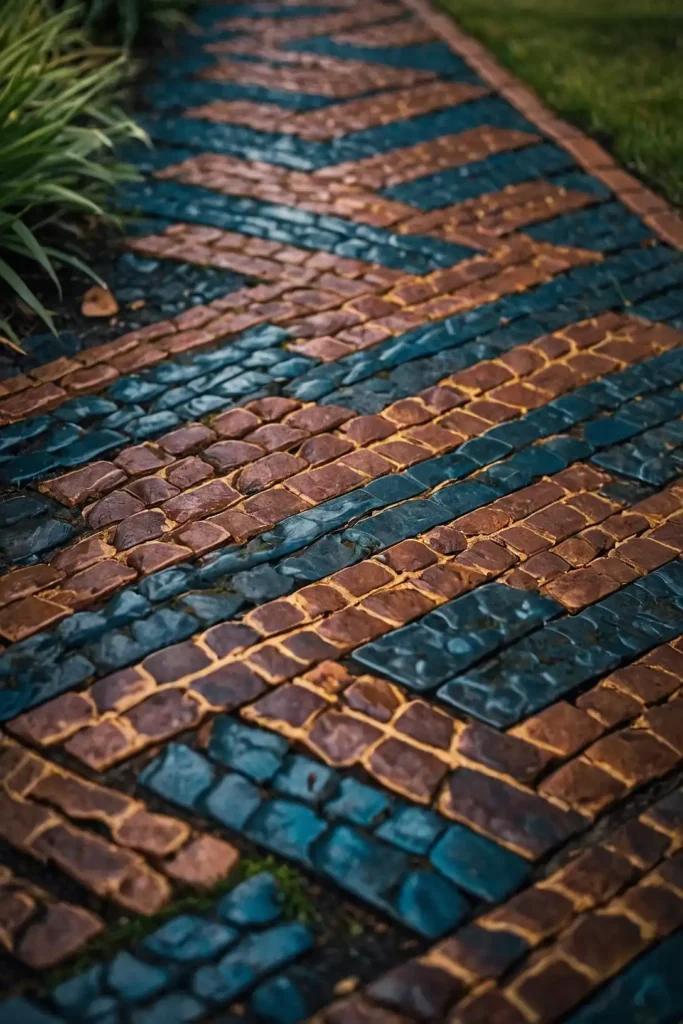
Arrange standard bricks in a classic herringbone pattern to create a pathway with timeless appeal and excellent stability.
This traditional technique adds sophisticated texture to both formal and cottage gardens.
Set bricks at 45-degree angles to the path direction, creating interlocking zig-zags that distribute weight effectively and prevent individual bricks from shifting.
This pattern works equally well in straight or curved pathways.
Edge your brick path with contrasting materials like steel edging, concrete curbing, or a single row of bricks set vertically for a clean, defined border.
11: Crushed Seashell Path
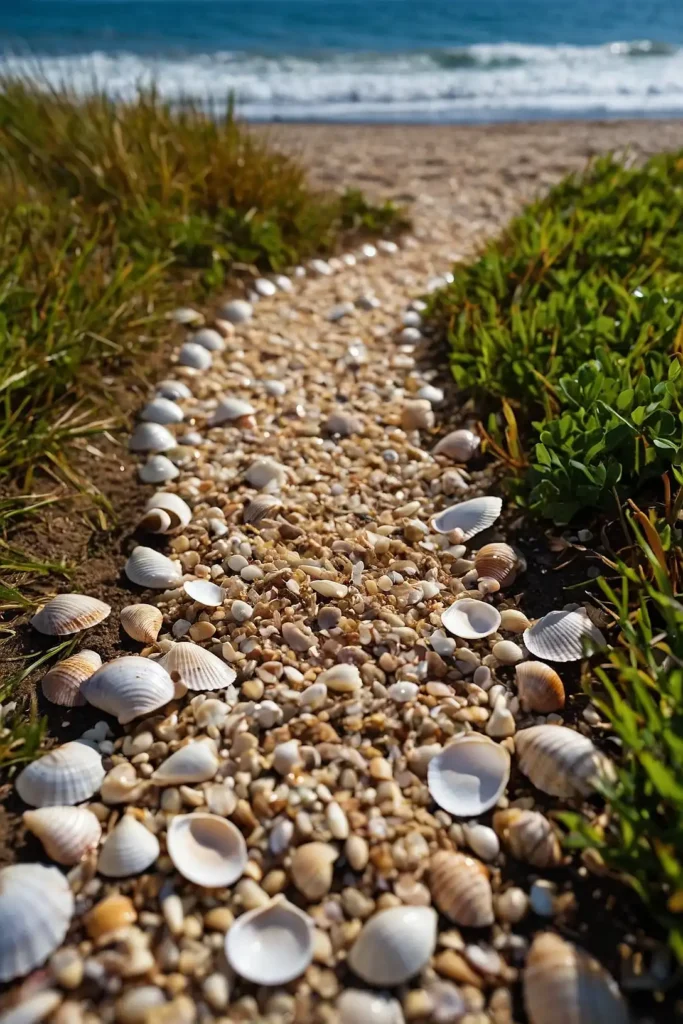
Create a coastal-inspired walkway using crushed seashells that brighten garden spaces while providing excellent drainage.
This natural material adds textural interest and a subtle beach atmosphere.
Compact the shells over a weed barrier and gravel base for stability, creating a crisp-sounding surface that alerts you to visitors.
The white shells reflect moonlight, naturally illuminating evening strolls.
Edge your path clearly to contain the shells, and expect that they’ll gradually decompose over time, adding beneficial calcium to surrounding soil while requiring occasional replenishment.
12: Wine Cork Stepping Stones
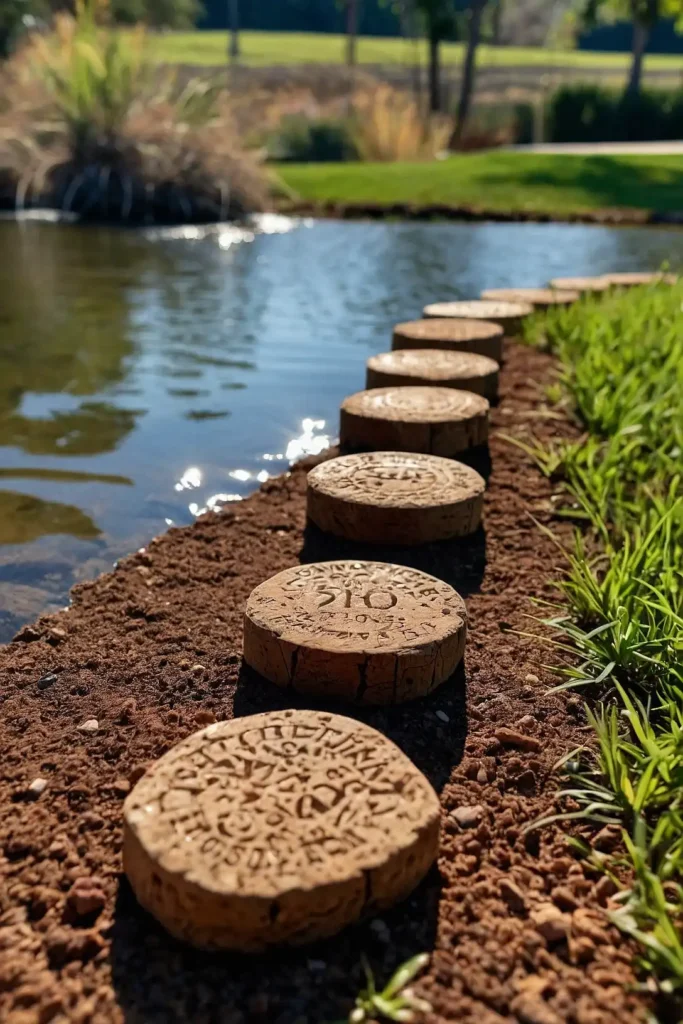
Transform collected wine corks into unique stepping stones that display your personality while reusing materials.
This conversation-starting pathway works well in small sections or intimate garden nooks.
Set corks vertically into concrete forms, creating textured stepping stones with excellent grip even in wet conditions.
The natural variation in cork colors creates subtle, interesting patterns.
Protect your finished cork pavers with clear outdoor sealant to extend their lifespan, and place them strategically as accent elements within a larger pathway system.
13: Spiral Stone Pattern
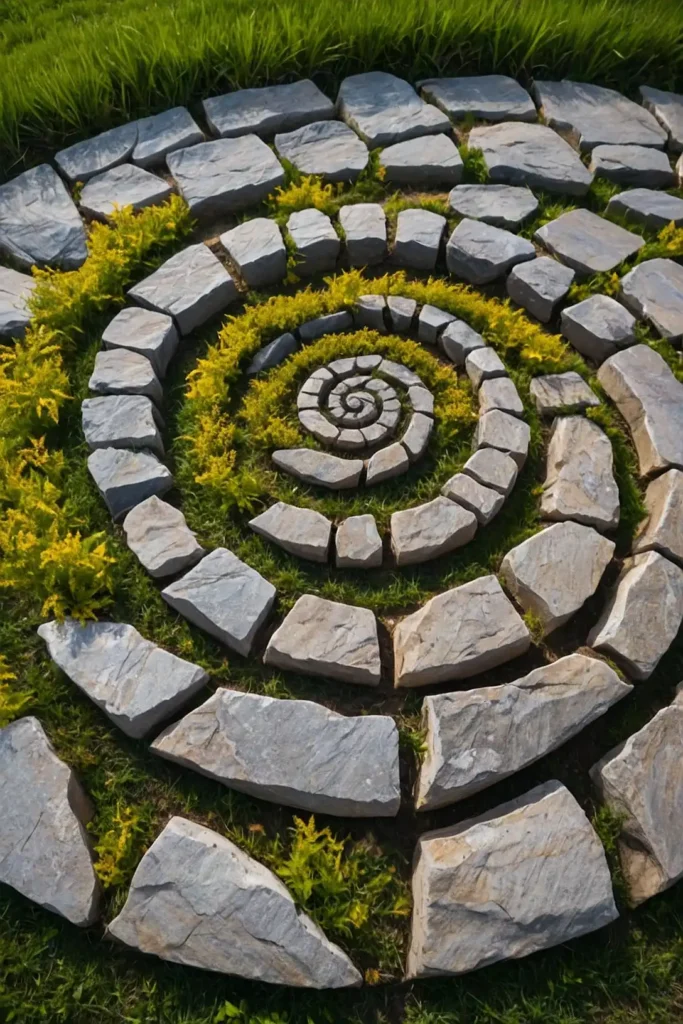
Design an eye-catching spiral pattern using contrasting stone or concrete pavers that creates a focal point within your garden journey.
This artistic approach transforms a simple path into a destination feature.
Create your spiral using materials in two contrasting colors or textures, working outward from a central point.
The mathematical precision of a perfect spiral adds sophisticated design elements to natural settings.
Position this distinctive feature at garden intersections, outside meditation spaces, or as a transitional element between different landscape zones for maximum impact.
14: Grass-Growing Pavers
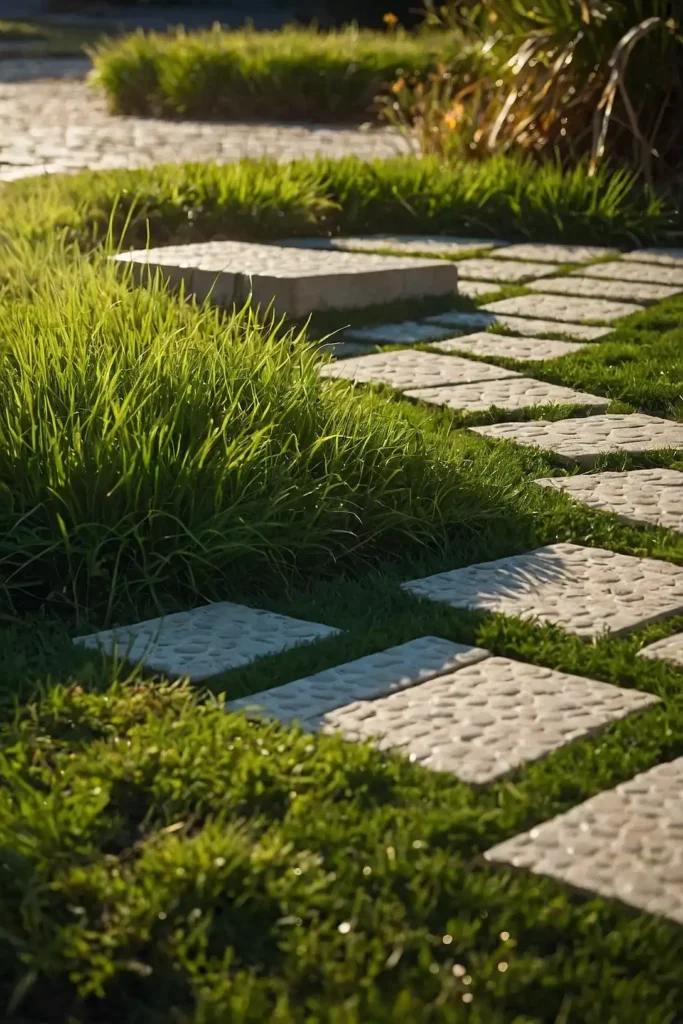
Install specialized grid pavers that allow grass to grow through openings while providing solid support for walking or even occasional vehicle traffic.
This eco-friendly approach blends pathways seamlessly into lawns.
Choose concrete or recycled plastic grid systems designed specifically for this purpose, fill the cells with quality topsoil, and seed with durable grass varieties adapted to your local conditions.
The resulting path appears as a subtle green corridor through your lawn that can withstand regular foot traffic while maintaining permeability for excellent stormwater management.
15: Railroad Tie Steps
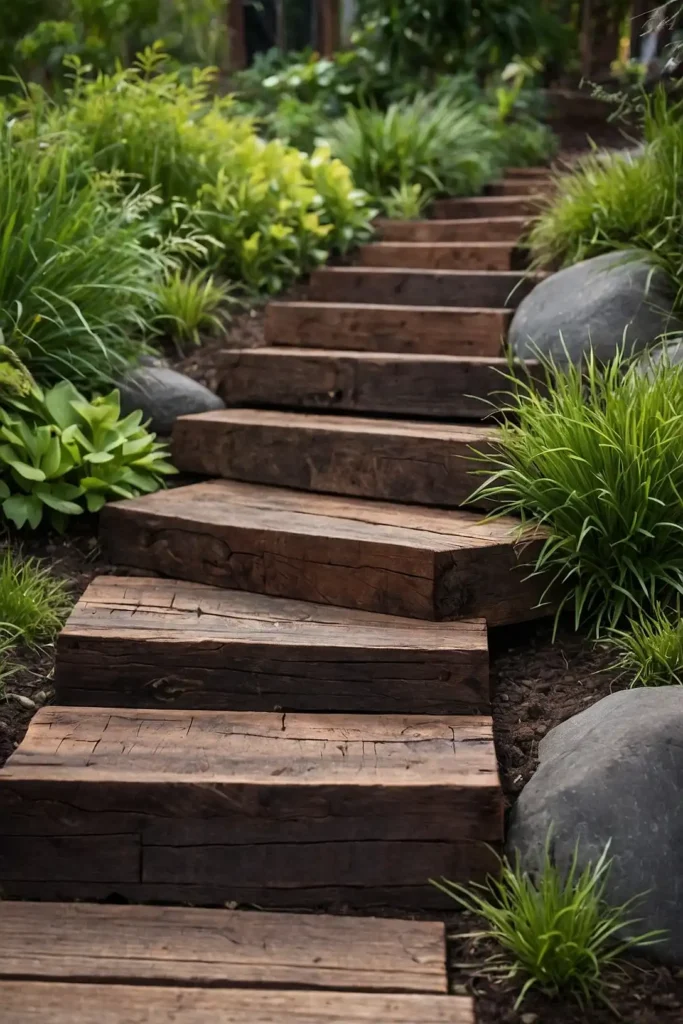
Utilize reclaimed railroad ties to create rustic steps and pathways on sloped terrain.
This substantial approach adds structural interest while solving the practical challenge of navigating elevation changes.
Position ties horizontally across the slope, securing them with rebar stakes driven through pre-drilled holes.
Fill behind each tie with compacted gravel and soil to create level walking surfaces.
Consider adding solar riser lights to improve visibility and safety after dark, particularly important for these substantial step elements.
16: Inlaid Stone Mandala
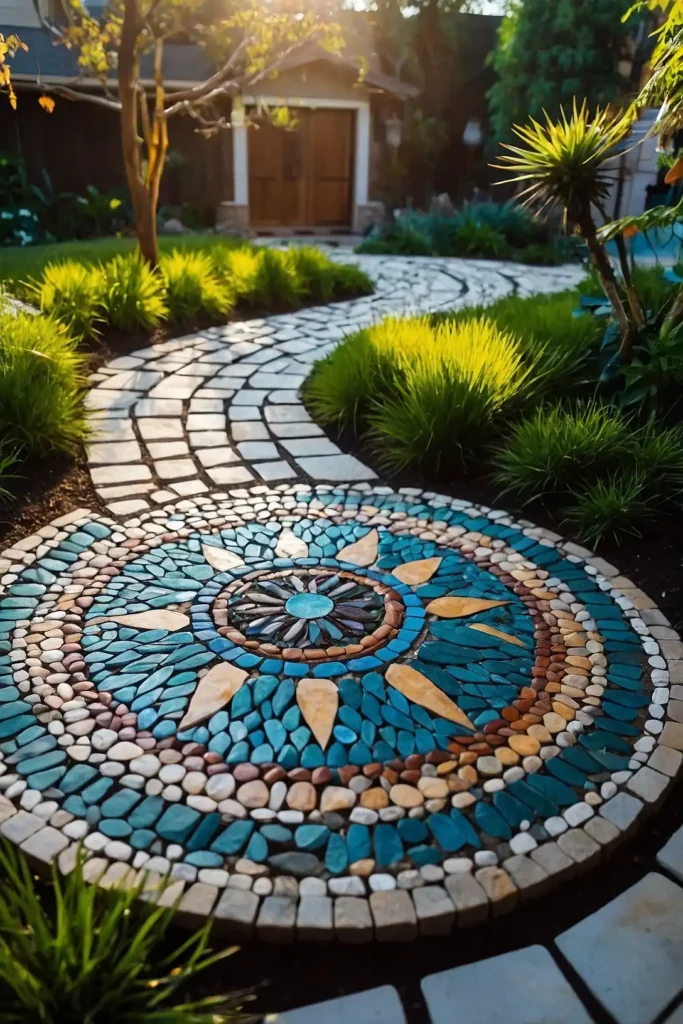
Create a stunning focal point by designing an inlaid stone mandala as a special feature within your pathway system.
This artistic installation transforms a functional element into garden art.
Design your pattern using contrasting stones set in concrete, working from a central point outward in circular patterns.
Even simple geometric designs create impressive results when executed with precision.
Position your mandala at a garden crossroads, entryway, or natural pause point where visitors can appreciate the detailed craftsmanship from multiple angles.
17: Natural Flagstone Ribbon
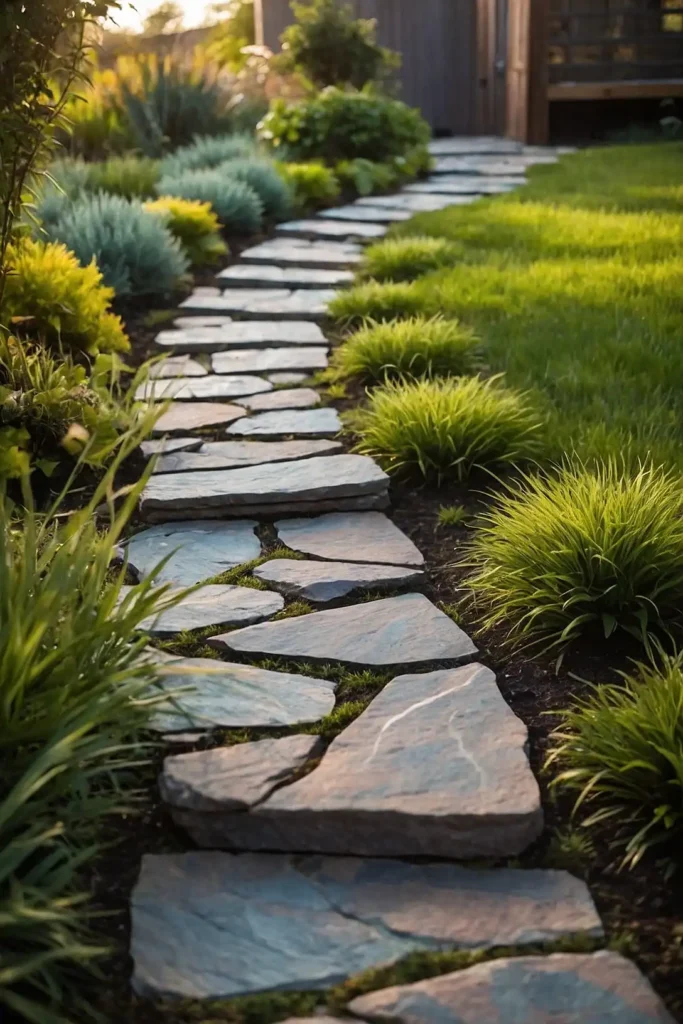
Create a graceful, winding pathway using irregular flagstone pieces set with wide joints that allow groundcover planting.
This organic approach blends naturally with informal garden styles.
Select stones of varying sizes but similar thicknesses, arranging them to follow natural movement patterns through your landscape.
The irregular edges create gentle flow rather than rigid lines.
Plant creeping groundcovers like ajuga, sedum, or Irish moss between stones to soften the pathway and integrate it with surrounding garden plantings.
18: Wooden Slice and Pebble Mix
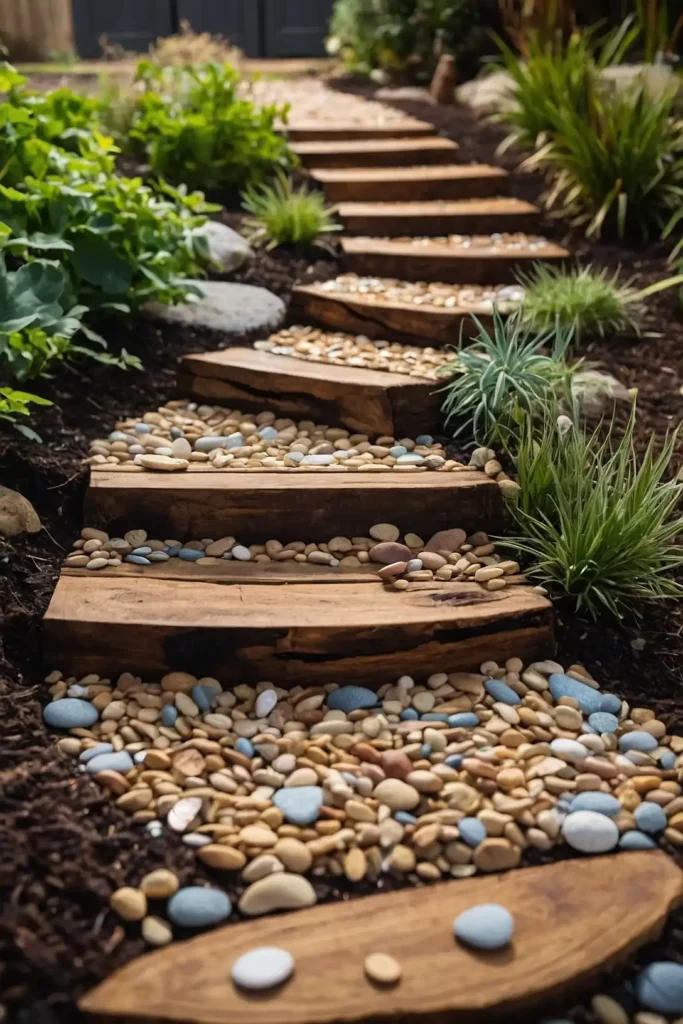
Combine round wood slices with decorative pebbles to create a textural pathway with natural elements.
This combination offers visual interest while providing practical walking surfaces.
Embed wood slices partially into a bed of small, consistent-sized pebbles, creating a stable, well-drained path foundation.
The contrasting materials create rhythm and pattern as you move through the space.
Expect the wood elements to weather naturally over time, developing character and eventually requiring replacement as they decompose and return to the soil.
19: Children’s Adventure Path
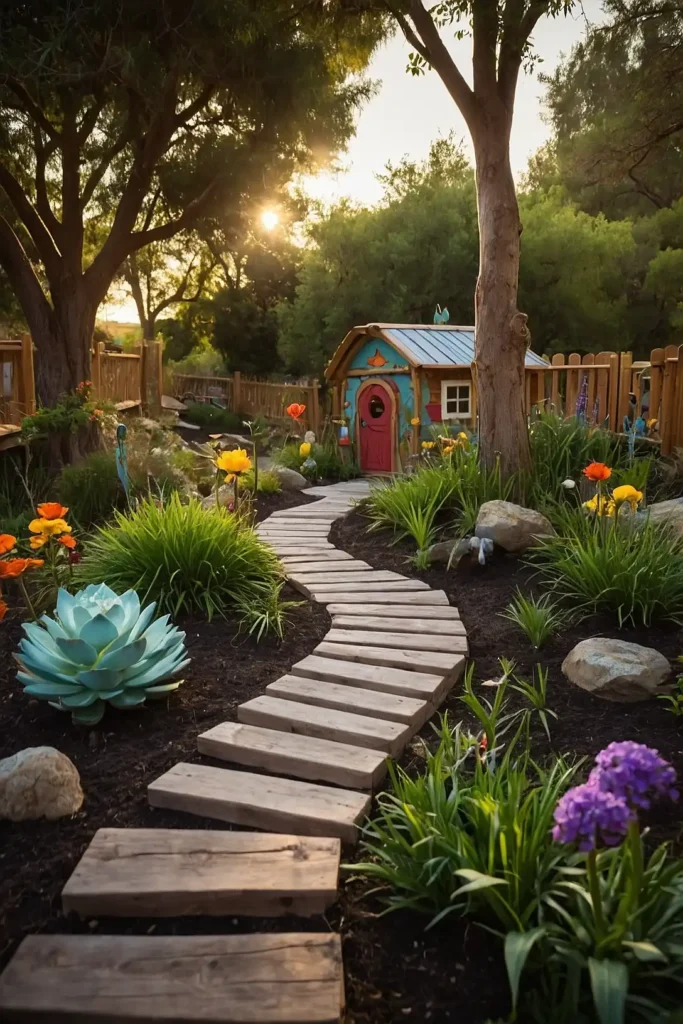
Design an interactive pathway specifically for younger garden explorers, incorporating playful elements like hopscotch patterns, animal footprints, or treasure hunt clues.
This family-friendly approach makes garden journeys into adventures.
Create concrete stepping stones with embedded treasures, footprints, or game patterns that encourage jumping, counting, or imagination.
Position them to create a dedicated children’s circulation route.
Include child-height points of interest along the path—small sculptures, fairy garden elements, or special plants with sensory qualities that enhance the journey.
20: Poured Concrete with Inlays
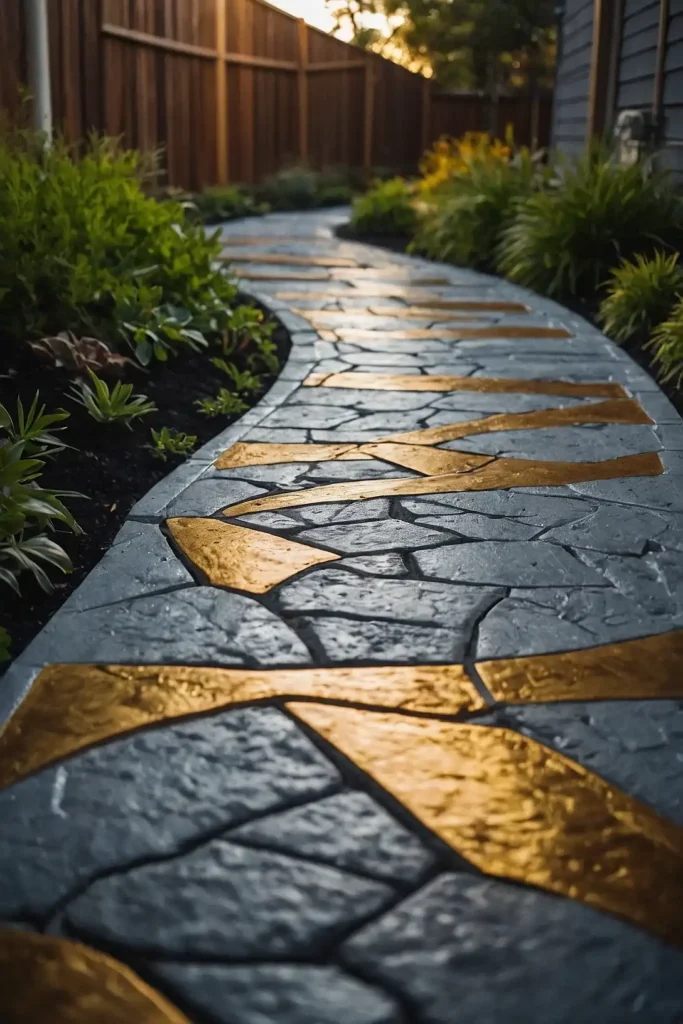
Design a contemporary pathway using poured concrete with decorative inlays of contrasting materials.
This modern approach allows endless customization while providing durable, maintenance-free performance.
Incorporate strips of metal, glass, tile, or contrasting aggregates into your concrete forms before pouring.
These inlays can create geometric patterns, flowing lines, or even text and images.
Consider adding integral color to your concrete mix for a more sophisticated result than standard gray, choosing earth tones that complement your landscape palette.
21: Musical Stone Path
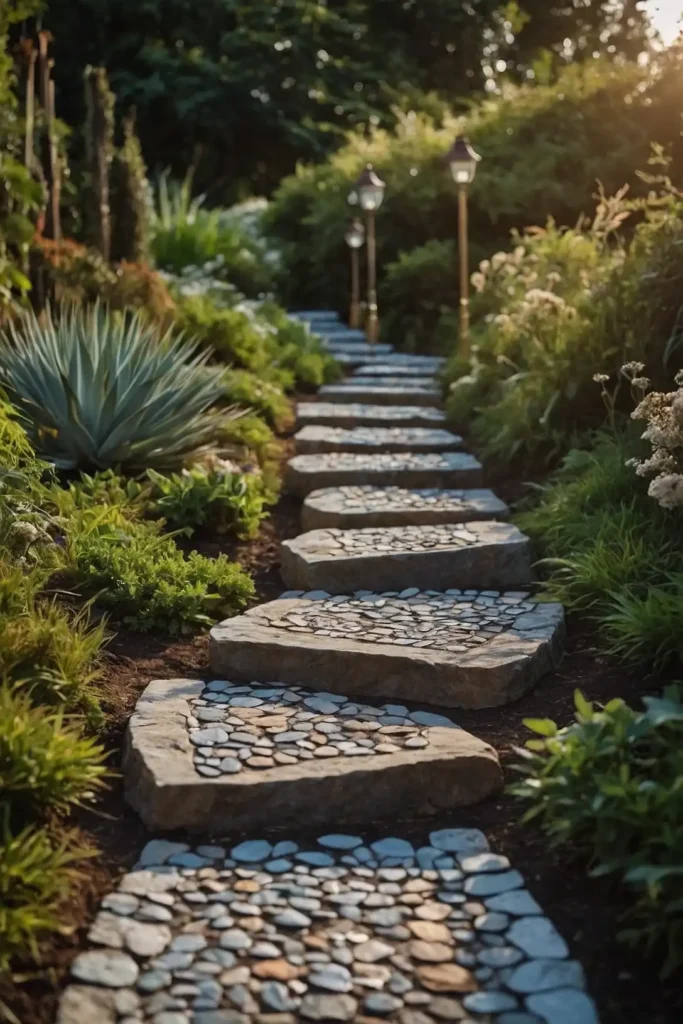
Create an interactive sound experience by incorporating musical elements into your pathway design.
This playful approach adds an unexpected sensory dimension to garden exploration.
Install weather-resistant chimes, bells, or percussion elements adjacent to stepping stones, or create hollow elements within the path itself that produce sounds when stepped upon. The varying tones create a walking melody.
This unique feature particularly appeals to children and the young at heart, making your garden path a destination rather than simply a means of transit.
22: Basket weave Pattern Pavers
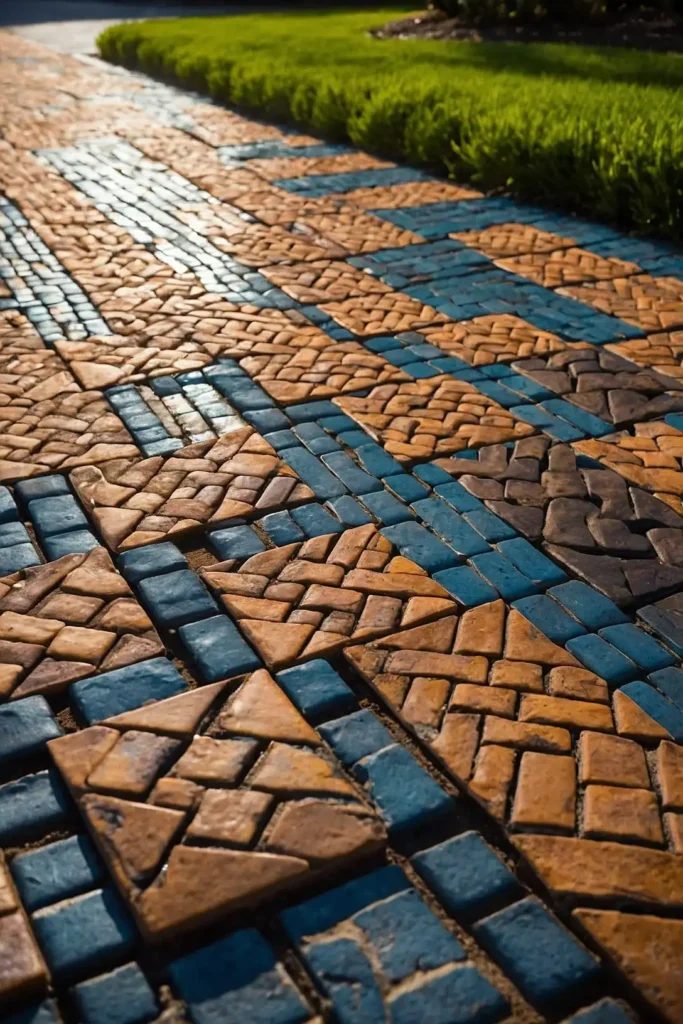
Arrange rectangular pavers in a classic basket weave pattern to create a pathway with timeless appeal and visual texture.
This traditional technique adds sophisticated interest without overwhelming your landscape design.
Alternate the orientation of same-sized rectangular pavers to create interlocking units that distribute weight effectively.
This stable pattern works well for both primary pathways and high-use garden areas.
Edge your path with a soldier course of bricks or contrasting material to frame the pattern and create a clean, defined border between path and planted areas.
23: Painted Stone Path
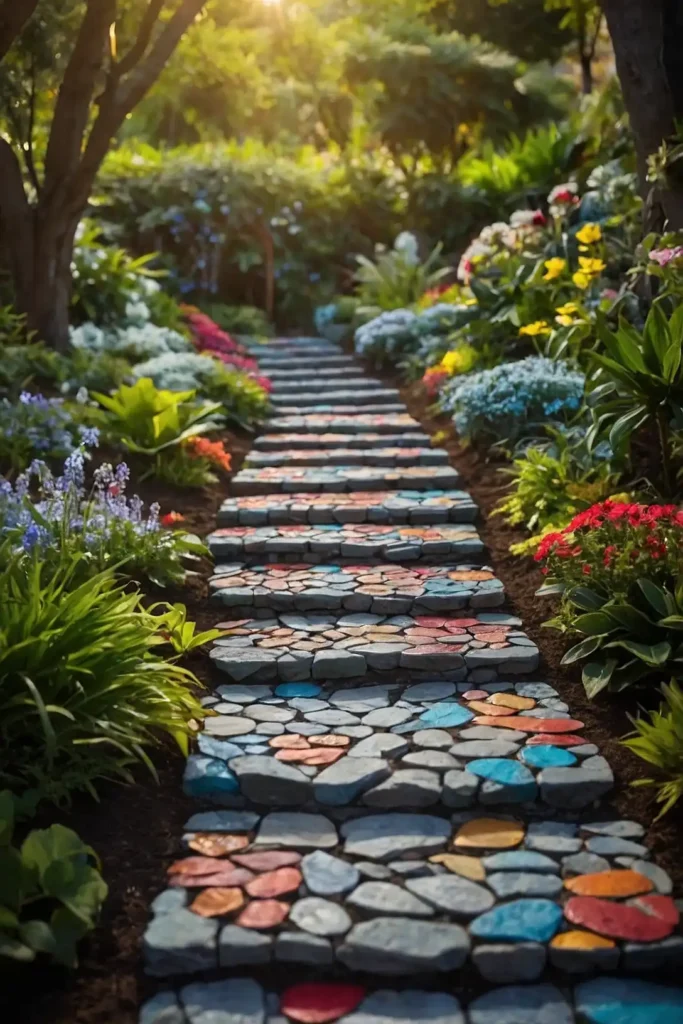
Transform ordinary concrete pavers or flat stones into vibrant art pieces by painting them with outdoor-grade colors and designs.
This personalized approach adds unexpected whimsy to garden journeys.
Create cohesive themes like geometric patterns, native flora and fauna representations, or abstract designs using colors that complement your garden palette.
Seal finished stones with clear outdoor protectant.
Use these painted elements as special accents within a larger pathway system, creating moments of discovery and delight rather than an entire route of painted pieces.
24: Timber and Gravel Combination
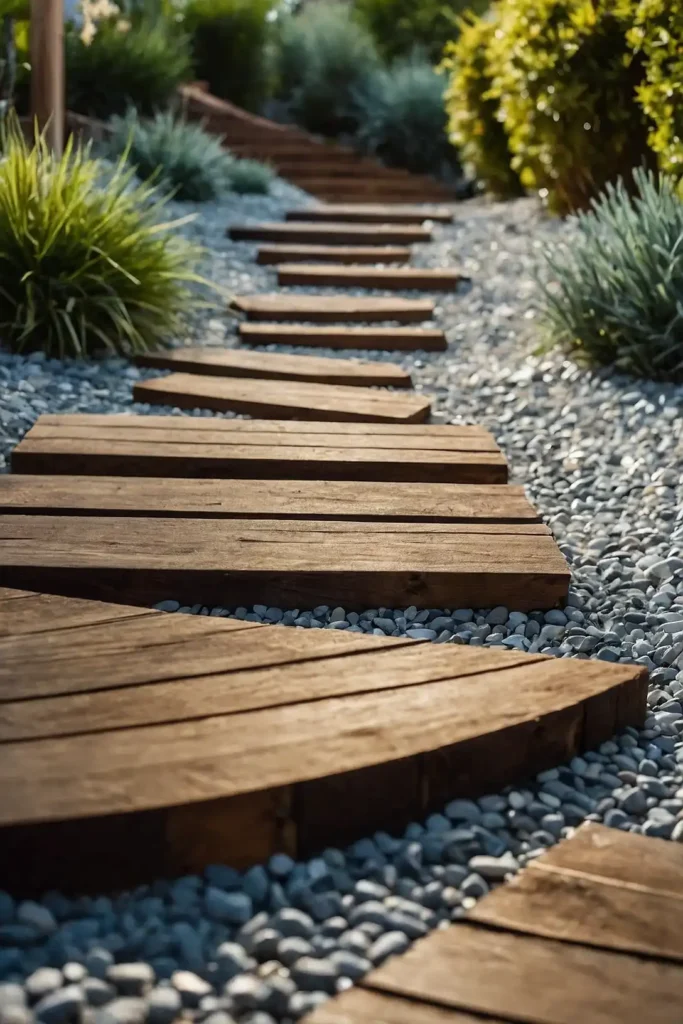
Construct a defined pathway using timber edging filled with decorative gravel for a clean, low-maintenance garden feature.
This versatile design works in both formal and informal landscapes.
Install pressure-treated lumber or cedar timbers as edging, securing them with stakes and creating a level base for your gravel fill.
The wood containment keeps gravel from spreading into garden beds.
Choose gravel in a color that complements your landscape, considering darker tones for contemporary spaces or warmer hues for more natural settings.
25: Vertical Timber Rounds
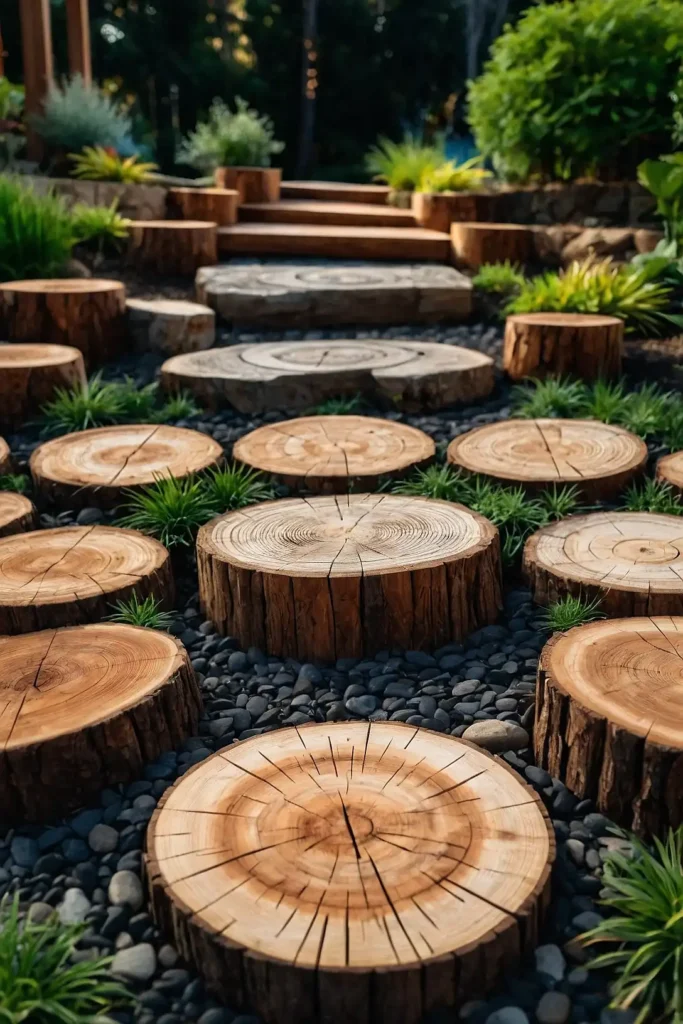
Create a distinctive path using timber rounds set vertically into the ground like cobblestones.
This organic approach adds textural interest while repurposing tree materials.
Cut uniform sections from logs or branches, varying the diameters for visual interest while maintaining consistent heights. Set them tightly together in a bed of sand for stability.
The end-grain surfaces provide fascinating natural patterns that weather beautifully over time, with each round displaying unique ring patterns and character.
26: Concrete Leaf Castings
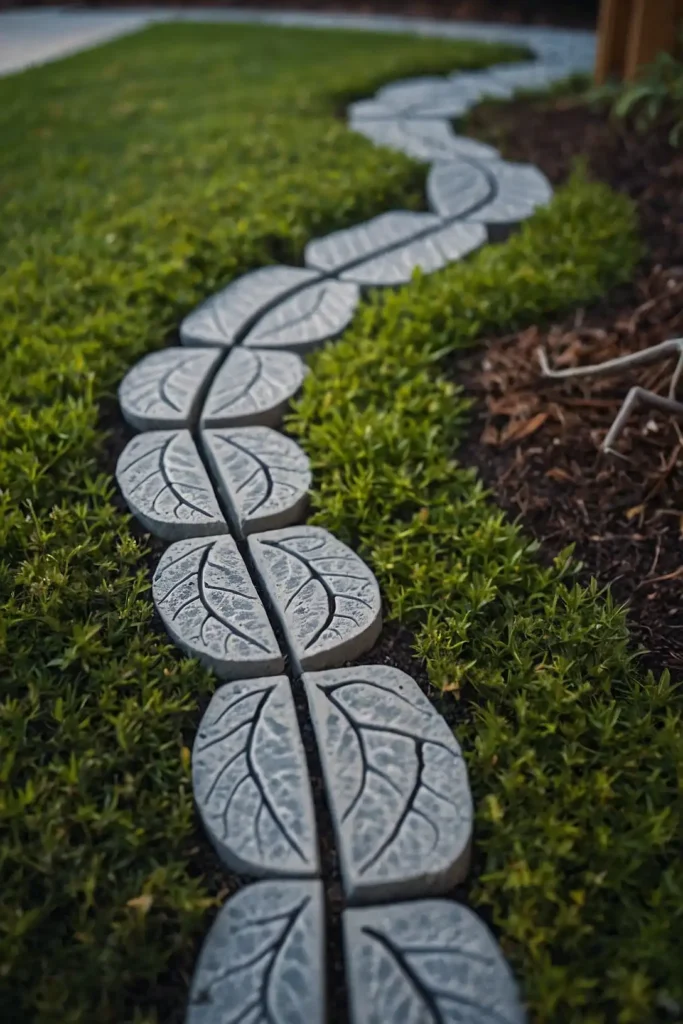
Create nature-inspired stepping stones using concrete castings of large leaves like rhubarb, Hosta, or elephant ear.
This artistic approach incorporates garden elements into pathway design.
Make impressions of leaf veins and textures in wet concrete to create detailed natural patterns that become permanent pathway elements.
Add concrete colorant that complements your garden palette.
Arrange these botanical stepping stones among gravel or groundcover to create a path that celebrates your garden’s flora in a functional, lasting format.
27: Glow-in-the-Dark Aggregate
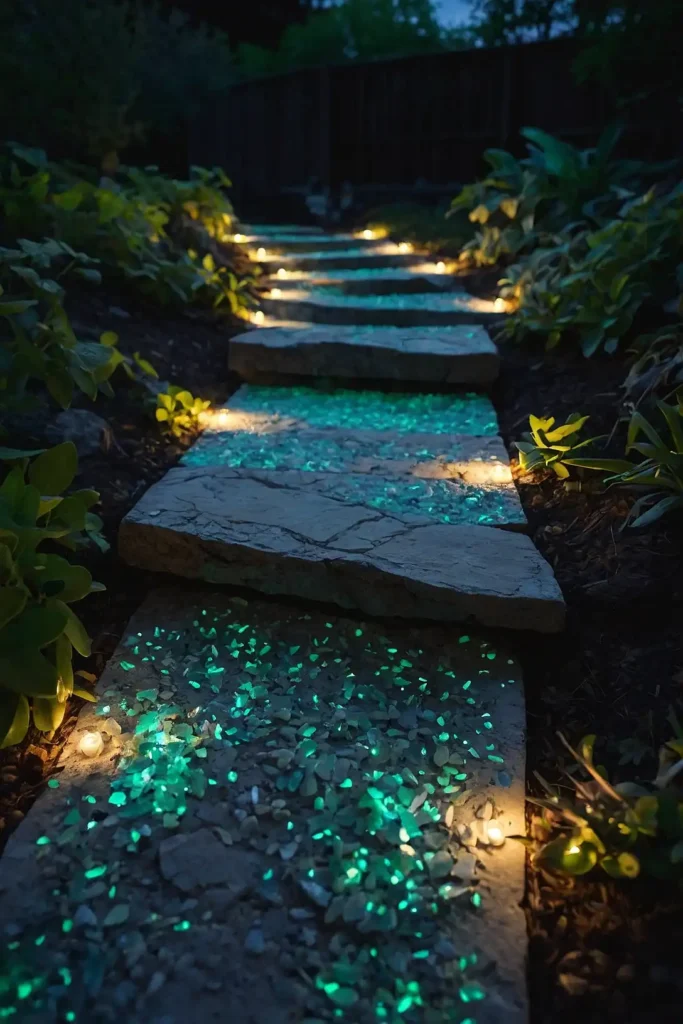
Incorporate luminous aggregate into concrete or resin pathway materials to create magical nighttime illumination without electrical components.
This innovative approach transforms your garden after dark.
Mix glow-in-the-dark stones or chips into concrete when creating stepping stones or pathways, or use them as gap fillers between larger pavers.
These materials absorb sunlight during the day and emit a soft glow for hours after dark.
The subtle illumination provides both enchantment and practical safety benefits, gently marking the path without disrupting the evening atmosphere or natural habitat.
Conclusion
Pathways connect not just different areas of your landscape but also create emotional journeys through your outdoor space.
By choosing creative materials, patterns, and designs, you’ll transform simple garden circulation into memorable experiences that enhance your yard’s personality.

